A compass saw is a type of saw used for making curved cuts known as compasses, particularly in confined spaces where a larger saw would not fit. [1] [2]
A compass saw is a type of saw used for making curved cuts known as compasses, particularly in confined spaces where a larger saw would not fit. [1] [2]
Compass saws have a narrow, tapered blade usually ending in a sharp point, typically with a tooth pitch of 2.5 to 3 mm (eight to ten teeth per inch), [2] but down to 1.3 mm (up to 20 teeth per inch) for harder materials and as long as 5 mm (few as five teeth per inch) for softer materials. [1] They have a curved, light "pistol grip" handle, designed for work in confined spaces and overhead. [2]
The blade of a compass saw may be fixed or retractable, and are typically interchangeable. Partially retracting the blade can prevent flexing and breaking when cutting harder materials. [1]
Compass saws are suitable for cutting softer woods, plastic, drywall, and non-ferrous metals. [1] [2] The pointed tip of the blade can be used to penetrate softer materials without the need for a pilot hole. [1]
Compared with other saws designed for cutting curves, such as coping or fretsaws, compass saws have a larger blade and longer pitch (fewer teeth per inch). This allows them to cut faster, and to cut through thicker materials, but leaves a rougher finish. [2]
Compared with drywall saws, compass saws typically have a longer blade – at 15 to 30 centimetres (5.9 to 12 in) – and shorter pitch (more teeth per inch). [1] [2]
Keyhole saws, also called padsaws or jab saws, feature shorter, finer blades and (often) straight handles, and are suitable for cutting extremely tight curves. [2] [3]
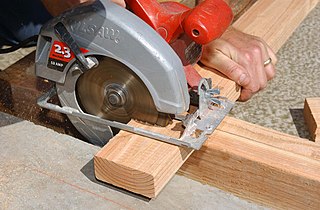
A circular saw is a power-saw using a toothed or abrasive disc or blade to cut different materials using a rotary motion spinning around an arbor. A hole saw and ring saw also use a rotary motion but are different from a circular saw. Circular saws may also be loosely used for the blade itself. Circular saws were invented in the late 18th century and were in common use in sawmills in the United States by the middle of the 19th century.
A saw is a tool consisting of a tough blade, wire, or chain with a hard toothed edge. It is used to cut through material, very often wood, though sometimes metal or stone. The cut is made by placing the toothed edge against the material and moving it back and forth, or continuously forward. This force may be applied by hand, or powered by steam, water, electricity or other power source. An abrasive saw has a powered circular blade designed to cut through metal or ceramic.

A blade is the portion of a tool, weapon, or machine with an edge that is designed to puncture, chop, slice or scrape surfaces or materials. Blades are typically made from materials that are harder than those they are to be used on. Historically, humans have made blades from flaking stones such as flint or obsidian, and from various metal such as copper, bronze and iron. Modern blades are often made of steel or ceramic. Blades are one of humanity's oldest tools, and continue to be used for combat, food preparation, and other purposes.
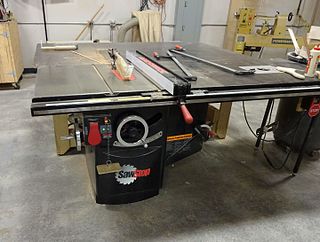
A table saw is a woodworking tool, consisting of a circular saw blade, mounted on an arbor, that is driven by an electric motor. The blade protrudes through the top of a table, which provides support for the material, usually wood, being cut.

The Japanese saw or nokogiri (鋸) is a type of saw used in woodworking and Japanese carpentry that cuts on the pull stroke, unlike most European saws that cut on the push stroke. Japanese saws are the best known pull saws, but they are also used in China, Iran, Iraq, Korea, Nepal and Turkey. Among European saws, both coping saws for woodworking and jeweler's saws for metal working also cut on the pull stroke like Japanese saws. Cutting on the pull stroke is claimed to cut more efficiently and leave a narrower cut width. On the other hand, a pull stroke does not easily permit putting one's body weight behind a stroke. This can be readily solved by using a vice or clamping. Another disadvantage, due to the arrangement and form of the teeth, is that Japanese saws do not work as well on hardwoods as European saws do. Japanese saws were originally intended for comparatively soft woods like cypress and pine whereas European saws were intended for hard woods like oak and maple.

A bandsaw is a power saw with a long, sharp blade consisting of a continuous band of toothed metal stretched between two or more wheels to cut material. They are used principally in woodworking, metalworking, and lumbering, but may cut a variety of materials. Advantages include uniform cutting action as a result of an evenly distributed tooth load, and the ability to cut irregular or curved shapes like a jigsaw. The minimum radius of a curve is determined by the width of the band and its kerf. Most bandsaws have two wheels rotating in the same plane, one of which is powered, although some may have three or four to distribute the load. The blade itself can come in a variety of sizes and tooth pitches, which enables the machine to be highly versatile and able to cut a wide variety of materials including wood, metal and plastic.
A hacksaw is a fine-toothed saw, originally and mainly made for cutting metal. The equivalent saw for cutting wood is usually called a bow saw.

A miter saw or mitre saw is a saw used to make accurate crosscuts and miters in a workpiece by positioning a mounted blade onto a board. A miter saw in its earliest form was composed of a back saw in a miter box, but in modern implementation consists of a powered circular saw that can be positioned at a variety of angles and lowered onto a board positioned against a backstop called the fence.

A kitchen knife is any knife that is intended to be used in food preparation. While much of this work can be accomplished with a few general-purpose knives – notably a large chef's knife, a tough cleaver, a small paring knife and some sort of serrated blade – there are also many specialized knives that are designed for specific tasks. Kitchen knives can be made from several different materials.
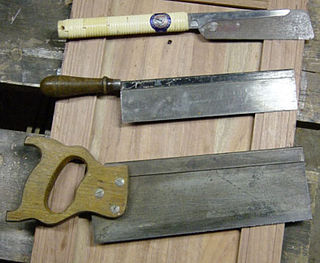
A backsaw is any hand saw which has a stiffening rib on the edge opposite the cutting edge, enabling better control and more precise cutting than with other types of saws. Backsaws are normally used in woodworking for precise work, such as cutting dovetails, mitres, or tenons in cabinetry and joinery. Because of the stiffening rib, backsaws are limited in the depth to which they can cut. Backsaws usually have relatively closely spaced teeth, often with little or no set.
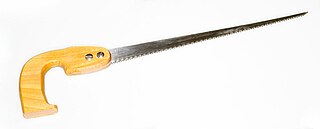
A keyhole saw is a long, narrow saw used for cutting small, often awkward features in various building materials. There are typically two varieties of keyhole saw: the fixed blade type and the retractable blade type.

Japanese carpentry was developed more than a millennium ago through Chinese architectural influences from the 12th century. It is a form of ancient Chinese wooden architecture and woodworking joints that involves building wooden furniture without the use of nails, screws, glue, or electric tools.

A scroll saw is a small electric or pedal-operated saw used to cut intricate curves in wood, metal, or other materials. The fineness of its blade allows it to cut more delicately than a power jigsaw, and more easily than a hand coping saw or fretsaw. Like those tools, it is capable of creating curves with edges, by pivoting its table.

A hole saw, also known as a hole cutter, is a saw blade of annular (ring) shape, whose annular kerf creates a hole in the workpiece without having to cut up the core material. It is used in a drill. Hole saws typically have a pilot drill bit (arbor) at their center to keep the saw teeth from walking. The fact that a hole saw creates the hole without needing to cut up the core often makes it preferable to twist drills or spade drills for relatively large holes (especially those larger than 25 millimetres. The same hole can be made faster and using less power.
Snips, also known as shears, are hand tools used to cut sheet metal and other tough webs. It is a cutting tool. Workers use various types of snips, with the cutting edges being straight or curved to various degrees. The style of edge employed will depend if a straight sheer or some type of shapes cut is necessary. There are two broad categories: tinner's snips, which are similar to common scissors, and compound-action snips, which use a compound leverage handle system to increase the mechanical advantage.

The fretsaw is a bow saw used for intricate cutting work which often incorporates tight curves. Although the coping saw is often used for similar work, the fretsaw is capable of much tighter radii and more delicate work. It has a distinctive appearance due to the depth of its frame, which together with the relatively short five-inch (13 cm) blade makes this tool appear somewhat out of proportion compared with most other saws.
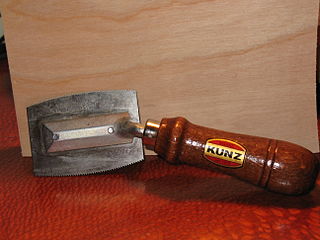
The veneer saw is a small double-edged tool for cutting thin hardwood veneer. Its narrow curved blade facilitates precision work, and its elevated offset handle makes it possible to cut flush with a surface. The blade is usually 75 or 100 millimetres long and it has 13 teeth per inch.
This glossary of woodworking lists a number of specialized terms and concepts used in woodworking, carpentry, and related disciplines.

An abrasive saw, also known as a cut-off saw or chop saw, is a circular saw which is typically used to cut hard materials, such as metals, tile, and concrete. The cutting action is performed by an abrasive disc, similar to a thin grinding wheel. Technically speaking this is not a saw, as it does not use regularly shaped edges (teeth) for cutting.

A jigsaw is a saw which uses a reciprocating blade to cut irregular curves, such as stenciled designs, in wood, metal, or other materials.